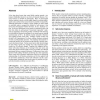Free Online Productivity Tools
i2Speak
i2Symbol
i2OCR
iTex2Img
iWeb2Print
iWeb2Shot
i2Type
iPdf2Split
iPdf2Merge
i2Bopomofo
i2Arabic
i2Style
i2Image
i2PDF
iLatex2Rtf
Sci2ools
APGV
2008
ACM
2008
ACM
Auditory self-motion illusions ("circular vection") can be facilitated by vibrations and the potential for actual motion
It has long been known that sound fields rotating around a stationary, blindfolded observer can elicit self-motion illusions ("circular vection") in 20-60% of participants. Here, we investigated whether auditory circular vection might depend on whether participants sense and know that actual motion is possible or impossible. Although participants in auditory vection studies are often seated on moveable seats to suspend the disbelief of self-motion, it has never been investigated whether this does, in fact, facilitate vection. To this end, participants were seated on a hammock chair with their feet either on solid ground ("movement impossible" condition) or suspended ("movement possible" condition) while listening to individualized binaural recordings of two sound sources rotating synchronously at 60/s. In addition, hardly noticeable vibrations were applied in half of the trials. Auditory circular vection was elicited in 8/16 participants. For those, addin...
| Added | 12 Oct 2010 |
| Updated | 12 Oct 2010 |
| Type | Conference |
| Year | 2008 |
| Where | APGV |
| Authors | Bernhard E. Riecke, Daniel Feuereissen, John J. Rieser |
Comments (0)

